Dynamics of Tree outside Forest Land Cover Development and Ecosystem Carbon Storage Change in Eastern Coastal Zone, Bangladesh
Abstract
:1. Introduction
2. Materials and Methods
2.1. Study Area
2.2. Satellite Data Acquisition
2.3. Image Processing
2.4. Image Classification
2.5. Accuracy Assessment
2.6. LULC Map Creation, Change Analysis and Mapping TOF Change
2.7. Carbon Storage Estimation
3. Results
3.1. LULC Change during 1988–2018
3.2. Dynamics of LULC Transformation during 1988–2018
3.3. Spatio-Temporal Distribution of TOF Development during 1988–2018
3.4. Carbon Storage Change during 1988–2018
4. Discussion
4.1. TOF Development, Carbon Storage Change, and Their Drivers
4.2. Limitations of the Study
5. Conclusions
Supplementary Materials
Author Contributions
Funding
Acknowledgments
Conflicts of Interest
Abbreviations
| AOI | Area of Interest |
| CO2 | Carbon Dioxide |
| CS | Carbon Storage |
| DEM | Digital Elevation Model |
| GIS | Geographical Information Systems |
| Gt | Gigatonnes |
| ha | Hectare |
| InVEST | Integrated Valuation of Ecosystem Services and Tradeoffs |
| km2 | Square Kilometers |
| Landsat TM | Landsat Thematic Mapper |
| LULC | Land Use/Land Cover |
| Mg C | Megagramme Carbon (1 Mg = 1 ton) |
| Mt | Metric ton |
| OLI-TIRS | Operational Land Imager and Thermal Infrared Sensor |
| Pg C | Petagram Carbon (1 Pg = 1 billion tons) |
| REDD+ | Reducing Emissions from Deforestation and Forest Degradation |
| ROI | Region of Interest |
| RS | Remote Sensing |
| SCP | Semi-Automated Classification Plugins |
| SDGs | Sustainable Development Goals |
| TOF | Tree Outside Forests |
| Tg C | Tera-grams of Carbon |
References
- Islam, K.R.; Weil, R.R. Land use effects on soil quality in a tropical forest ecosystem of Bangladesh. Agric. Ecosyst. Environ. 2000, 79, 9–16. [Google Scholar] [CrossRef]
- Le Quéré, C.; Andrew, R.M.; Friedlingstein, P.; Sitch, S.; Pongratz, J.; Manning, A.C.; Ivar Korsbakken, J.; Peters, G.P.; Canadell, J.G.; Jackson, R.B.; et al. Global Carbon Budget. Earth Syst. Sci. Data 2018, 10, 405–448. [Google Scholar] [CrossRef] [Green Version]
- FAO Forestry and Poverty Reduction. Available online: http://www.fao.org/forestry/livelihoods/en/ (accessed on 29 September 2021).
- GFW Global Deforestation Rates & Statistics by Country. Global Forest Watch. Available online: https://www.globalforestwatch.org/dashboards/global/?category=summary&dashboard (accessed on 25 May 2021).
- Leberger, R.; Rosa, I.M.D.; Guerra, C.A.; Wolf, F.; Pereira, H.M. Global patterns of forest loss across IUCN categories of protected areas. Biol. Conserv. 2020, 241, 108299. [Google Scholar] [CrossRef]
- Liu, Y.; Feng, Y.; Zhao, Z.; Zhang, Q.; Su, S. Socioeconomic drivers of forest loss and fragmentation: A comparison between different land use planning schemes and policy implications. Land Use Policy 2016, 54, 58–68. [Google Scholar] [CrossRef]
- Curtis, P.G.; Slay, C.M.; Harris, N.L.; Tyukavina, A.; Hansen, M.C. Classifying drivers of global forest loss. Science 2018, 361, 1108–1111. [Google Scholar] [CrossRef]
- Osland, M.J.; Feher, L.C.; López-Portillo, J.; Day, R.H.; Suman, D.O.; Guzmán Menéndez, J.M.; Rivera-Monroy, V.H. Mangrove forests in a rapidly changing world: Global change impacts and conservation opportunities along the Gulf of Mexico coast. Estuar. Coast. Shelf Sci. 2018, 214, 120–140. [Google Scholar] [CrossRef]
- Hoque, M.Z.; Cui, S.; Islam, I.; Xu, L.; Tang, J. Future impact of land use/land cover changes on ecosystem services in the lower meghna river estuary, Bangladesh. Sustainability 2020, 12, 2112. [Google Scholar] [CrossRef] [Green Version]
- Ghelardini, L.; Pepori, A.L.; Luchi, N.; Capretti, P.; Santini, A. Drivers of emerging fungal diseases of forest trees. For. Ecol. Manag. 2016, 381, 235–246. [Google Scholar] [CrossRef]
- Matuoka, M.A.; Benchimol, M.; Morante-Filho, J.C. Tropical forest loss drives divergent patterns in functional diversity of forest and non-forest birds. Biotropica 2020, 52, 738–748. [Google Scholar] [CrossRef]
- Hoque, M.Z.; Cui, S.; Islam, I.; Xu, L.; Ding, S. Dynamics of plantation forest development and ecosystem carbon storage change in coastal Bangladesh. Ecol. Indic. 2021, 130, 107954. [Google Scholar] [CrossRef]
- Latif, M.A.F.; Netzer, M.; Banik, H.; Chowdhury, R.M. Forest carbon inventory 2014 at eight protected areas in Bangladesh. Bangladesh For. Dep. Winrock Int. Dhaka 2015, 58, 41–42. [Google Scholar]
- BFD Forestry Types and Management, Bangladesh Forest Department (BFD), Dhaka. Available online: http://www.bforest.gov.bd/ (accessed on 24 February 2020).
- Nasim, F.A.; Hoque, M.Z.; Haque, M.E.; Islam, M.S.; Parveen, N.; Chakma, S.; Afrad, M.S.I. How Does Adoption of Crop Variety Reduce the Impact of Drought in Agriculture and Mitigate Food Insecurity of Smallholder Farmers? A Case Study on BUdhan1 Rice Variety in Bangladesh. Asian J. Agric. Ext. Econ. Sociol. 2019, 30, 1–12. [Google Scholar] [CrossRef]
- Hoque, M.Z.; Cui, S.; Xu, L.; Islam, I.; Tang, J.; Ding, S. Assessing agricultural livelihood vulnerability to climate change in coastal Bangladesh. Int. J. Environ. Res. Public Health 2019, 16, 4552. [Google Scholar] [CrossRef] [Green Version]
- Hoque, M.; Rahman, M.; Haque, M.; Afrad, M.; Rahman, M. Comparative Contribution of Crops and Homestead Forest Enterprises to Rural Household Economy: A Case Study of Keshorita Village in Bangladesh. Asian J. Adv. Agric. Res. 2018, 7, 1–16. [Google Scholar] [CrossRef]
- Huq, N.; Hugé, J.; Boon, E.; Gain, A.K. Climate change impacts in agricultural communities in rural areas of coastal bangladesh: A tale of many stories. Sustainability 2015, 7, 8437–8460. [Google Scholar] [CrossRef] [Green Version]
- Barua, S.K.; Boscolo, M.; Animon, I. Valuing forest-based ecosystem services in Bangladesh: Implications for research and policies. Ecosyst. Serv. 2020, 42, 101069. [Google Scholar] [CrossRef]
- Islam, M.R.; Abdullah, H.M.; Ahmed, Z.U.; Islam, I.; Ferdush, J.; Miah, M.G.; Miah, M.M.U. Monitoring the spatiotemporal dynamics of waterlogged area in southwestern Bangladesh using time series Landsat imagery. Remote Sens. Appl. Soc. Environ. 2018, 9, 52–59. [Google Scholar] [CrossRef]
- Abdullah, H.M.; Islam, I.; Miah, M.G.; Ahmed, Z. Quantifying the spatiotemporal patterns of forest degradation in a fragmented, rapidly urbanizing landscape: A case study of Gazipur, Bangladesh. Remote Sens. Appl. Soc. Environ. 2019, 13, 457–465. [Google Scholar] [CrossRef]
- Miah, M.; Ahmed, M. Traditional agroforestry in Bangladesh: Livelihood activities of the rural households. In Proceedings of the A Poster Presented at the XII World Forestry Congress, Quebec, QC, Canada, 21–28 September 2003. [Google Scholar]
- Irons, J.R.; Dwyer, J.L.; Barsi, J.A. The next Landsat satellite: The Landsat Data Continuity Mission. Remote Sens. Environ. 2012, 122, 11–21. [Google Scholar] [CrossRef] [Green Version]
- MacLachlan, A.; Biggs, E.; Roberts, G.; Boruff, B. Urban growth dynamics in Perth, Western Australia: Using applied remote sensing for sustainable future planning. Land 2017, 6, 9. [Google Scholar] [CrossRef] [Green Version]
- Abdullah, H.M.; Mahboob, M.G.; Banu, M.R.; Seker, D.Z. Monitoring the drastic growth of ship breaking yards in Sitakunda: A threat to the coastal environment of Bangladesh. Environ. Monit. Assess. 2013, 185, 3839–3851. [Google Scholar] [CrossRef]
- Liang, Y.; Hashimoto, S.; Liu, L. Integrated assessment of land-use/land-cover dynamics on carbon storage services in the Loess Plateau of China from 1995 to 2050. Ecol. Indic. 2021, 120, 106939. [Google Scholar] [CrossRef]
- Hernández-Guzmán, R.; Ruiz-Luna, A.; González, C. Assessing and modeling the impact of land use and changes in land cover related to carbon storage in a western basin in Mexico. Remote Sens. Appl. Soc. Environ. 2019, 13, 318–327. [Google Scholar] [CrossRef]
- Nelson, E.; Mendoza, G.; Regetz, J.; Polasky, S.; Tallis, H.; Cameron, D.R.; Chan, K.M.A.; Daily, G.C.; Goldstein, J.; Kareiva, P.M.; et al. Modeling multiple ecosystem services, biodiversity conservation, commodity production, and tradeoffs at landscape scales. Front. Ecol. Environ. 2009, 7, 4–11. [Google Scholar] [CrossRef]
- Zennaro, F.; Furlan, E.; Simeoni, C.; Torresan, S.; Aslan, S.; Critto, A.; Marcomini, A. Exploring machine learning potential for climate change risk assessment. Earth-Sci. Rev. 2021, 220, 103752. [Google Scholar] [CrossRef]
- Huq, N.; Bruns, A.; Ribbe, L. Interactions between freshwater ecosystem services and land cover changes in southern Bangladesh: A perspective from short-term (seasonal) and long-term (1973–2014) scale. Sci. Total Environ. 2019, 650, 132–143. [Google Scholar] [CrossRef]
- Hassan, M.S.; Mahmud-Ul-Islam, S.; Rahman, M.T. Integration of Remote Sensing and GIS to Assess Vulnerability of Environmental Degradation in North-Western Bangladesh. J. Geogr. Inf. Syst. 2015, 7, 494–505. [Google Scholar] [CrossRef] [Green Version]
- Islam, M.R.; Miah, M.G.; Inoue, Y. Analysis of Land use and Land Cover Changes in the Coastal Area of Bangladesh Using Landsat Imagery. Land Degrad. Dev. 2016, 27, 899–909. [Google Scholar] [CrossRef]
- Abdullah, A.Y.; Masrur, A.; Sarfaraz, M.; Adnan, G. Spatio-Temporal Patterns of Land Use/Land Cover Change in the Heterogeneous Coastal Region of Bangladesh between 1990 and 2017. Remote Sens. 2017, 7, 790. [Google Scholar] [CrossRef] [Green Version]
- BBS Population and Housing Census 2011, Bangladesh Bureau of Statistics, Ministry of Planning, Peoples’ Republic of Bangladesh, Dhaka, Bangladesh. 2011. Available online: http://203.112.218.65:8008/ (accessed on 27 November 2021).
- CDS. Coastal Development Strategy (CDS); Ministry of Water Resources: Dhaka, Bangladesh, 2006.
- Chowdhury, Q.S.; Hossain, Q. Bengal Delta in Banglapedia, National Encyclopedia of Bangladesh; Asiatic Society of Bangladesh: Dhaka, Bangladesh, 2006. [Google Scholar]
- Hossain, M.S. Biological aspects of the coastal and marine environment of Bangladesh. Ocean Coast. Manag. 2001, 44, 261–282. [Google Scholar] [CrossRef]
- Iftekhar, M.S. Conservation and management of the Bangladesh coastal ecosystem: Overview of an integrated approach. In Proceedings of the Natural Resources Forum; Wiley-Blackwell: Oxford, UK, 2006; Volume 30, pp. 230–237. [Google Scholar]
- ESRI ArcGIS Desktop: Release 10. Available online: https://www.esri.com/about/newsroom/arcnews/new-training-and-certification-offerings-from-esri-9/ (accessed on 27 September 2021).
- R Core Team. R version 3.4.2.; R Foundation for Statistical Computing: Vienna, Austria, 2017. [Google Scholar]
- Dibaba, W.T.; Demissie, T.A.; Miegel, K. Drivers and Implications of Land Use/Land Cover Dynamics in Finchaa Catchment, Northwestern Ethiopia. Land 2020, 9, 113. [Google Scholar] [CrossRef] [Green Version]
- Zhao, M.; He, Z.; Du, J.; Chen, L.; Lin, P.; Fang, S. Assessing the effects of ecological engineering on carbon storage by linking the CA-Markov and InVEST models. Ecol. Indic. 2019, 98, 29–39. [Google Scholar] [CrossRef]
- MoEFCC The Submission of Bangladesh’s Forest Reference Level for REDD+ under the UNFCCC; Ministry of Environment, Forest and Climate Change (MoEFCC), Government of Bangladesh: Dhaka, Bangladesh, 2018. Available online: https://redd.unfccc.int/files/2019_submiss (accessed on 1 June 2021).
- Ma, T.; Li, X.; Bai, J.; Ding, S.; Zhou, F.; Cui, B. Four decades’ dynamics of coastal blue carbon storage driven by land use/land cover transformation under natural and anthropogenic processes in the Yellow River Delta, China. Sci. Total Environ. 2019, 655, 741–750. [Google Scholar] [CrossRef]
- Sahu, S.C.; Kumar, M.; Ravindranath, N.H. Carbon stocks in natural and planted mangrove forests of Mahanadi Mangrove Wetland, East Coast of India. Curr. Sci. 2016, 110, 2253–2260. [Google Scholar] [CrossRef]
- FAO Training Mannual on Inventory of Trees Outside of Forests (TOF). Available online: https://www.fao.org/3/i5588e/i5588e.pdf (accessed on 1 June 2021).
- Banglapedia National Encyclopedia of Bangladesh-Forest and Forestry. Asiatic Society of Bangladesh, Dhaka. Available online: https://en.banglapedia.org/index.php/Hill_Forest (accessed on 1 June 2021).
- Ahmed, M.; Suphachalasai, S. Assessing the Costs of Climate Change and Adaptation in South Asia; Asian Development Bank: Mandaluyong, Philippines, 2014. [Google Scholar]
- Ahmed, A. Some of the major environmental problems relating to land use changes in the coastal areas of Bangladesh: A review. J. Geogr. Reg. Plan. 2011, 4, 1–8. [Google Scholar]
- Butt, A.; Shabbir, R.; Ahmad, S.S.; Aziz, N. Land use change mapping and analysis using Remote Sensing and GIS: A case study of Simly watershed, Islamabad, Pakistan. Egypt. J. Remote Sens. Sp. Sci. 2015, 18, 251–259. [Google Scholar] [CrossRef] [Green Version]
- Zoran, M.; Anderson, E. The use of multi-temporal and multispectral satellite data for change detection analysis of the Romanian Black Sea coastal zone. J. Optoelectron. Adv. Mater. 2006, 8, 252–256. [Google Scholar]
- Zhang, R.; Zhu, D. Study of land cover classification based on knowledge rules using high-resolution remote sensing images. Expert Syst. Appl. 2011, 38, 3647–3652. [Google Scholar] [CrossRef]
- Wu, S.Y.; Yarnal, B.; Fisher, A. Vulnerability of coastal communities to sea-level rise: A case study of Cape May County, New Jersey, USA. Clim. Res. 2002, 22, 255–270. [Google Scholar] [CrossRef] [Green Version]
- Kaliraj, S.; Chandrasekar, N.; Ramachandran, K.K.; Srinivas, Y.; Saravanan, S. Coastal landuse and land cover change and transformations of Kanyakumari coast, India using remote sensing and GIS. Egypt. J. Remote Sens. Sp. Sci. 2017, 20, 169–185. [Google Scholar] [CrossRef]
- Haque, S.A. Salinity problems and crop production in coastal regions of Bangladesh. Pak. J. Bot. 2006, 38, 1359–1365. [Google Scholar]
- Chowdhury, A.K.M.H.U.; Haque, M.E.; Hoque, M.Z.; Rokonuzzam, M. Adoption of BRRI Dhan47 in the Coastal Saline areas of Bangladesh. Agric. J. 2012, 7, 286–291. [Google Scholar] [CrossRef]
- Alam, S.M.N.; Philips, M.J. Coastal Shrimp Aquaculture Systems in Southwestern Bangladesh. Asian Fish. Sci. 2004, 17, 175–189. [Google Scholar] [CrossRef]
- Haque, A.; Alam, J.B.; Shaha, N.K.; Raihan, F. Study on Land Use Pattern Change and Its Causes. Int. J. Environ. Res. 2008, 2, 199–204. [Google Scholar]
- Do, F. Yearbook of Fisheries Statistics of Bangladesh; Director General Department of Fisheries: Dhaka, Bangladesh, 2018; Volume 35, p. 129. [Google Scholar]
- Islam, M.R. Managing Diverse Land Uses in Coastal Bangladesh: Institutional Approaches. Environ. Livelihoods Trop. Coast. Zones 2006, 18, 237. [Google Scholar]
- Minar, M.H.; Hossain, M.B.; Shamsuddin, M.D. Climate change and coastal zone of Bangladesh: Vulnerability, resilience and adaptability. Middle East J. Sci. Res. 2013, 13, 114–120. [Google Scholar] [CrossRef]
- Rahman, M.M.; Giedraitis, V.R.; Lieberman, L.S.; Akhtar, M.T.; Taminskienė, V. Shrimp Cultivation with Water Salinity in Bangladesh: The Implications of an Ecological Model. Univers. J. Public Health 2013, 1, 131–142. [Google Scholar] [CrossRef]
- Sarwar, M.G.M. Impacts of Sea Level Rise on the Coastal Zone of Bangladesh. Available online: https://www.lumes.lu.se/sites/lumes.lu.se/files/golam_sarwar.pdf (accessed on 1 June 2021).
- Rashid, S.; Alam, M.; Shamsuddin, S. Development of Island in the Meghna Estuary Over the Past 250 Years. In Climate Change: Issues and Perspectives for Bangladesh; Ahmed, R., Shamsuddin, S.D., Eds.; Sahitya Prokash: Dhaka, Bangladesh, 2011. [Google Scholar]
- Alam, M.; Uddin, K. A study of morphological changes in the coastal areas and offshore islands of Bangladesh using remote sensing. Am. J. Geogr. Inf. Syst. 2013, 2, 15–18. [Google Scholar] [CrossRef]
- Mörner, N. Climate change and Sea level changes in Bangladesh. Energy Environ. 2010, 21, 235–249. [Google Scholar] [CrossRef]
- Hoque, M.Z.; Cui, S.; Lilai, X.; Islam, I.; Ali, G.; Tang, J. Resilience of coastal communities to climate change in Bangladesh: Research gaps and future directions. Watershed Ecol. Environ. 2019, 1, 42–56. [Google Scholar] [CrossRef]
- World Economic Forum Here’s What You Need to Know about Bangladesh’s Rocketing Economy. Available online: https://www.weforum.org/agenda/2019/11/bangladesh-gdp-economy-asia/ (accessed on 24 February 2020).
- UN Digital Library. The World’s Cities in 2016-DATA; Department of Economic and Social Affairs, Population Division, United Nations: New York, NY, USA, 2016. [Google Scholar]
- Khatun, M. Climate Change and Migration in Bangladesh: Golden Bengal to Land of Disasters. Bangladesh E-J. Sociol. 2013, 10, 64–79. [Google Scholar]
- Prodhan, F.A.; Zhang, J.; Sharma, T.P.P.; Nanzad, L.; Zhang, D.; Seka, A.M.; Ahmed, N.; Hasan, S.S.; Hoque, M.Z.; Mohana, H.P. Projection of future drought and its impact on simulated crop yield over South Asia using ensemble machine learning approach. Sci. Total Environ. 2022, 807, 151029. [Google Scholar] [CrossRef]
- Latif, M.; Alam, M.; Mustafa, M. Floristic Diversity, Growth Statistics and Indigenous Management Techniques of Traditional Homegardens in Bangladesh. In Final Report of a Contract; Research Project of BARC; BFRI and IFESCU: Chittagong, Bangladesh, 2001. [Google Scholar]
- The World Bank. Rural Population-Bangladesh; World Bank: Washington, DC, USA, 2019. [Google Scholar]
- Chowdhury, M.; Islam, M.; Satter, M. Homestead Vegetable Production in Bangladesh. In Proceedings of the a Workshop on Vegetable Production and Marketing, Gazipur, Bangladesh, 26–29 January 1992; AVRDC: Dhaka, Bangladesh, 1992; pp. 64–77. [Google Scholar]
- FSES. Fact Searching and Intervention, 1996–FSES Publication No. 71, FSES; Bangladesh Agricultural University (BAU): Mymensingh, Bangladesh, 1999. [Google Scholar]
- Helen Keller International. Monitoring of activities in village nurseries and household gardens. In A Summary Report of Surveys 14–17 under NGO Gardening and Nutrition Education Surveillance Project; Helen Keller International: Dhaka, Bangladesh, 2001. [Google Scholar]
- Ma, S.; Smailes, M.; Zheng, H.; Robinson, B.E. Who is Vulnerable to Ecosystem Service Change? Reconciling Locally Disaggregated Ecosystem Service Supply and Demand. Ecol. Econ. 2019, 157, 312–320. [Google Scholar] [CrossRef]
- Li, J.; Gong, J.; Guldmann, J.M.; Li, S.; Zhu, J. Carbon dynamics in the northeastern qinghai-tibetan plateau from 1990 to 2030 using landsat land use/cover change data. Remote Sens. 2020, 12, 528. [Google Scholar] [CrossRef] [Green Version]
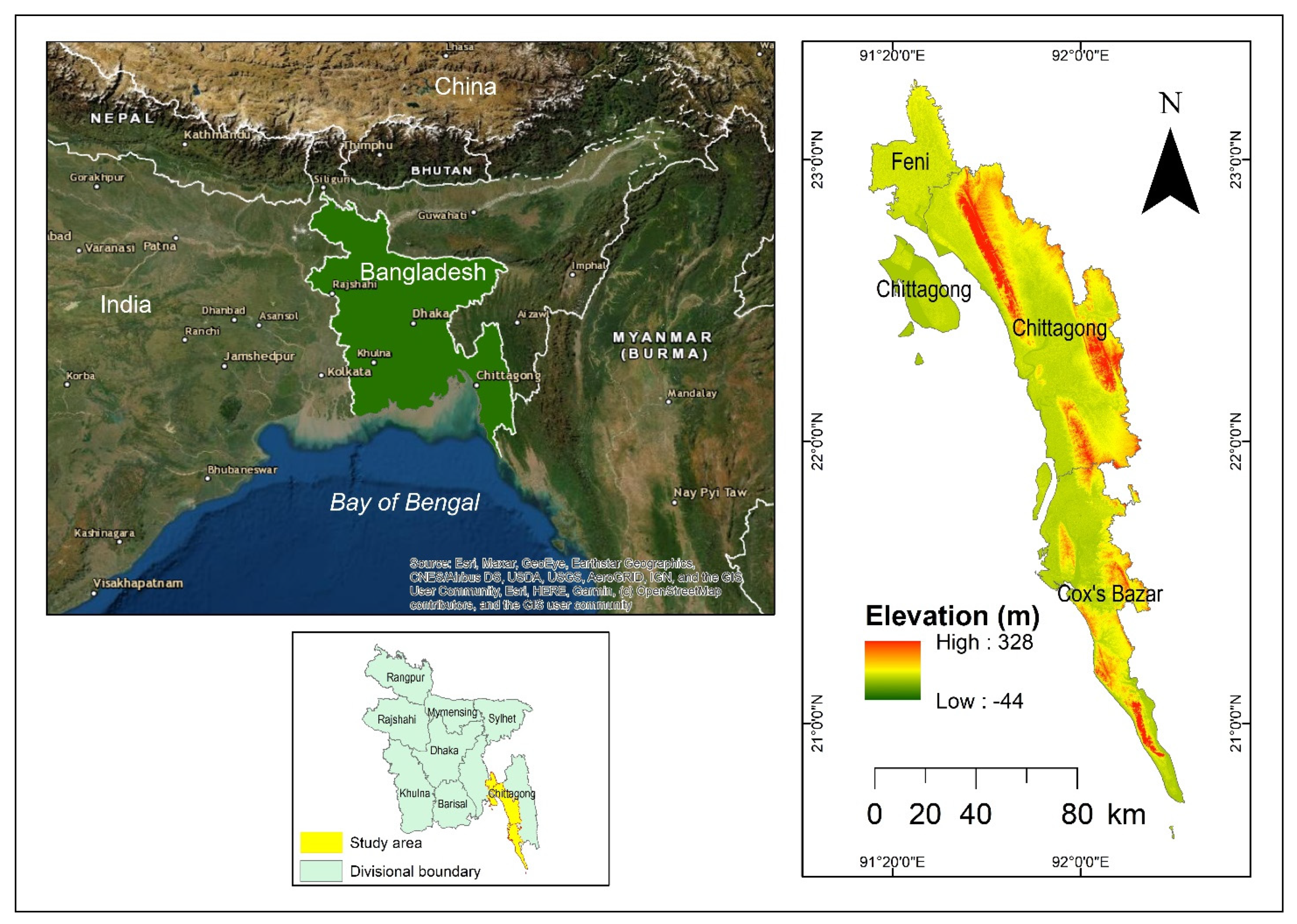
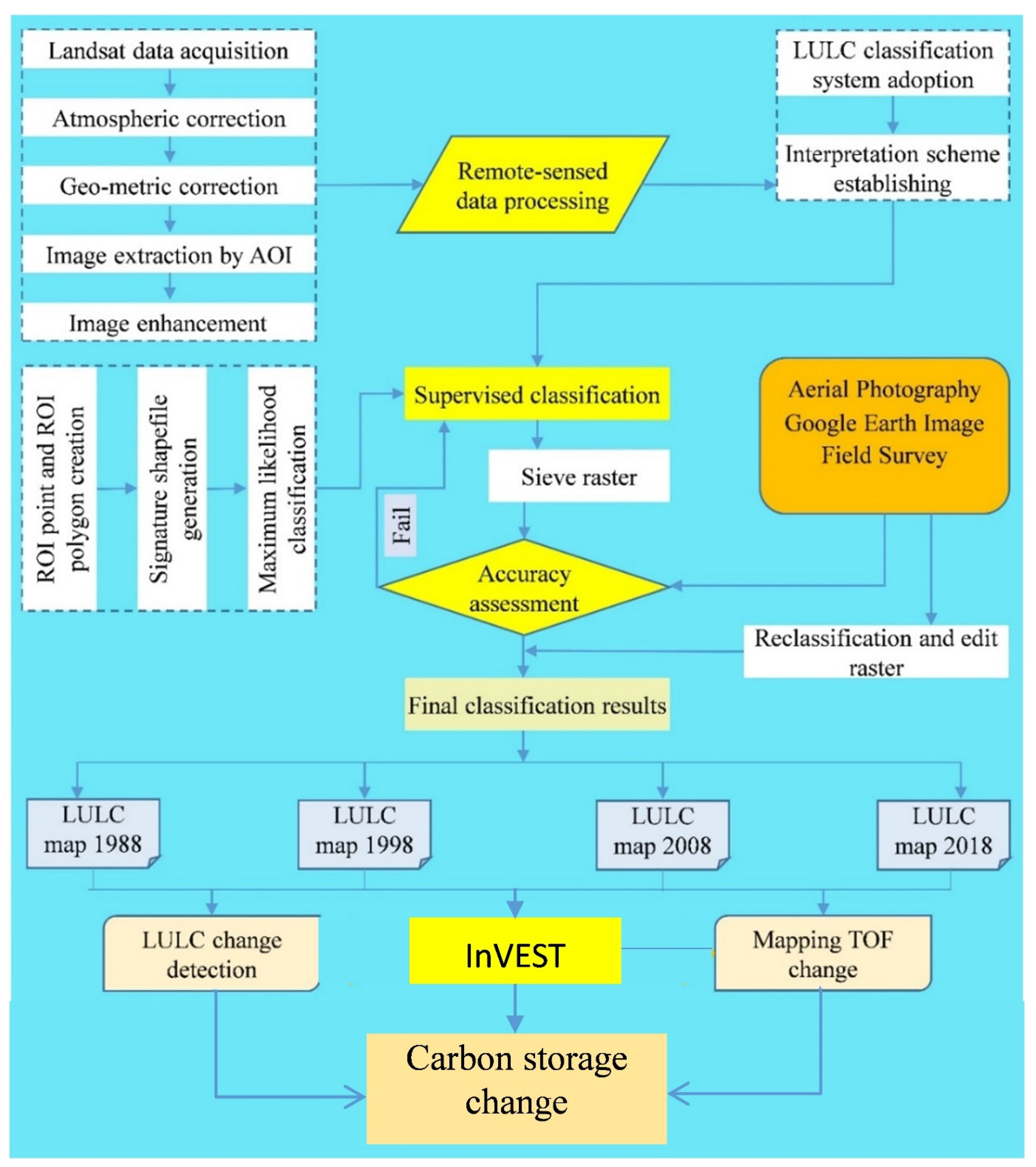
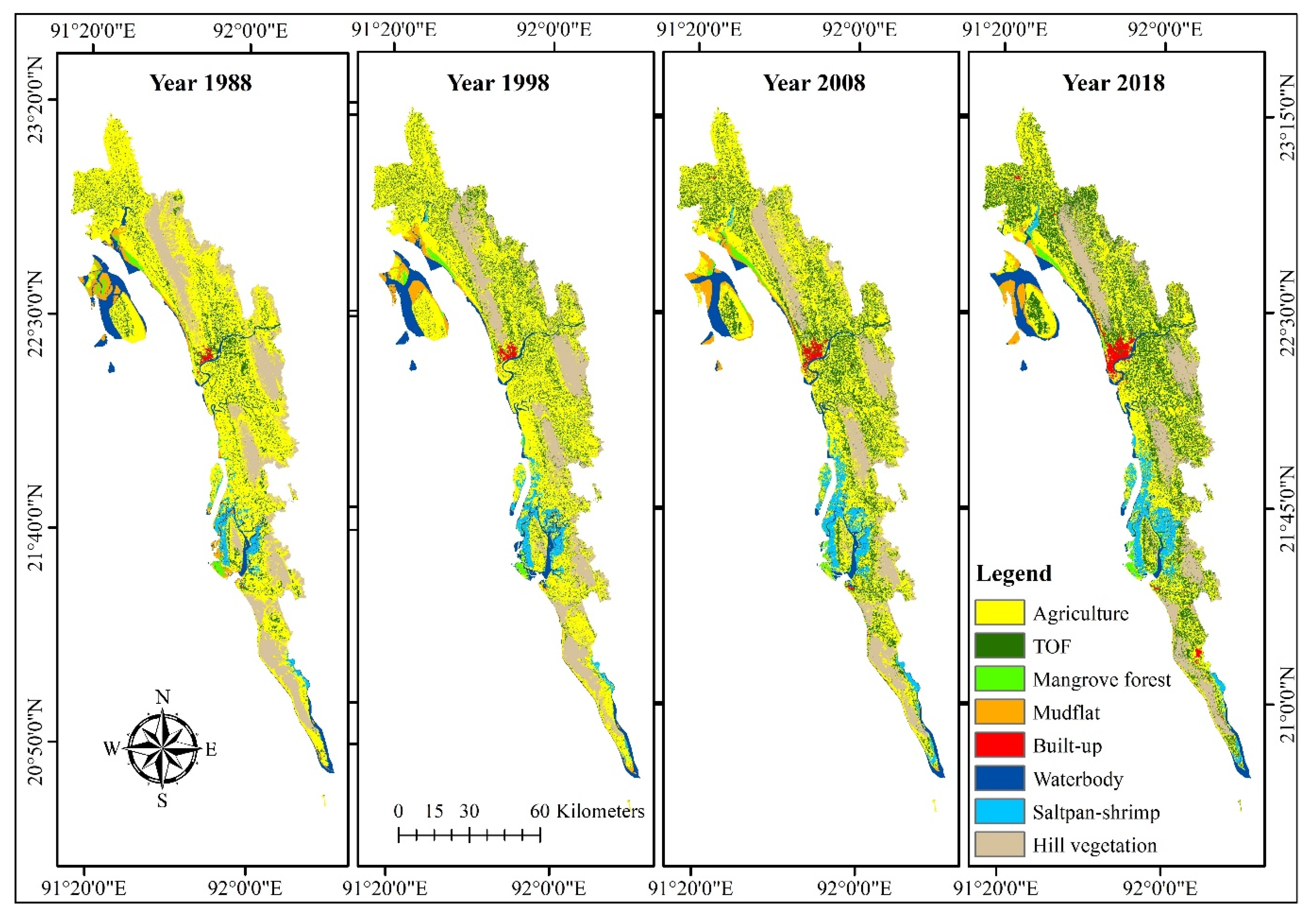
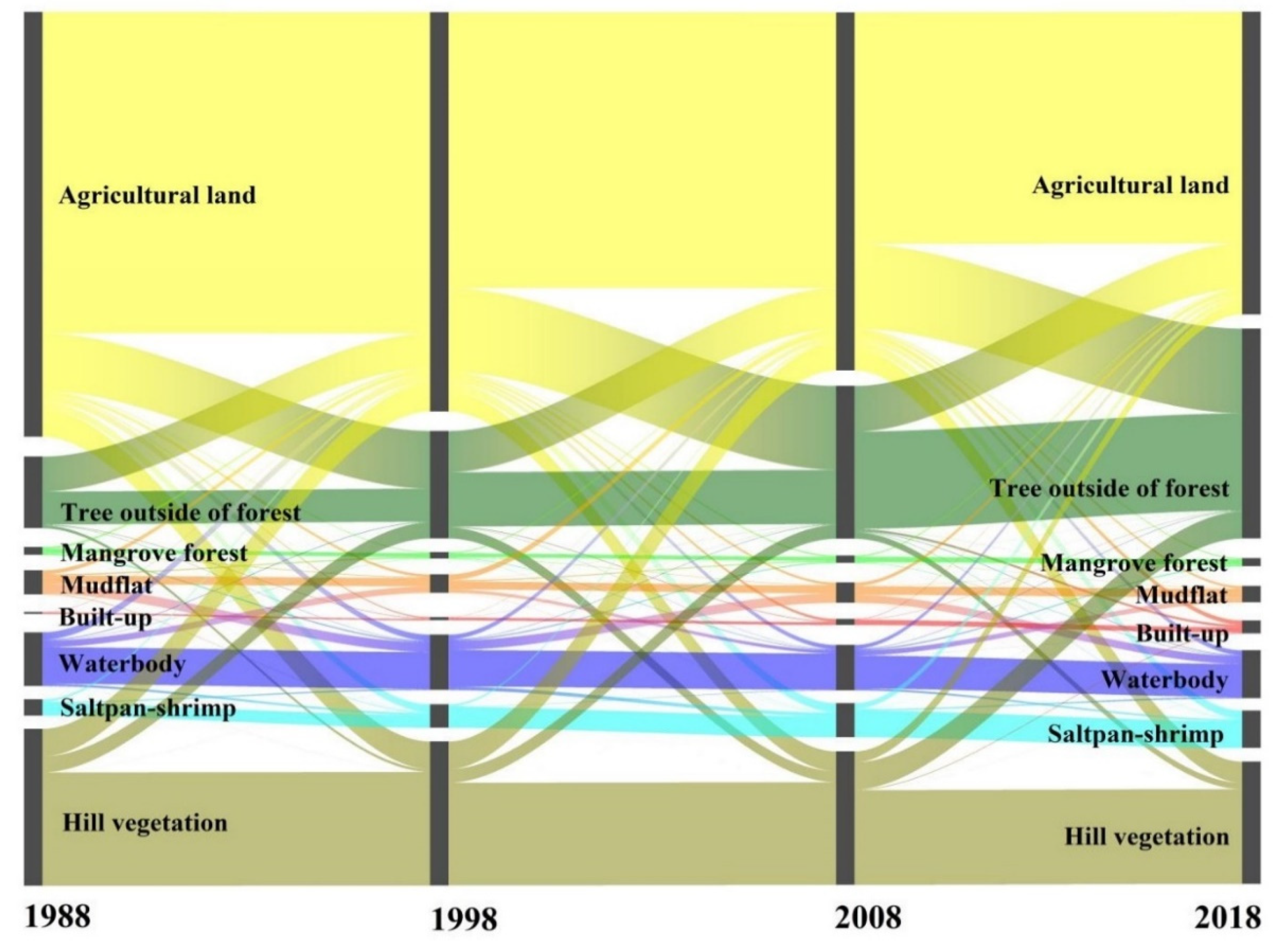
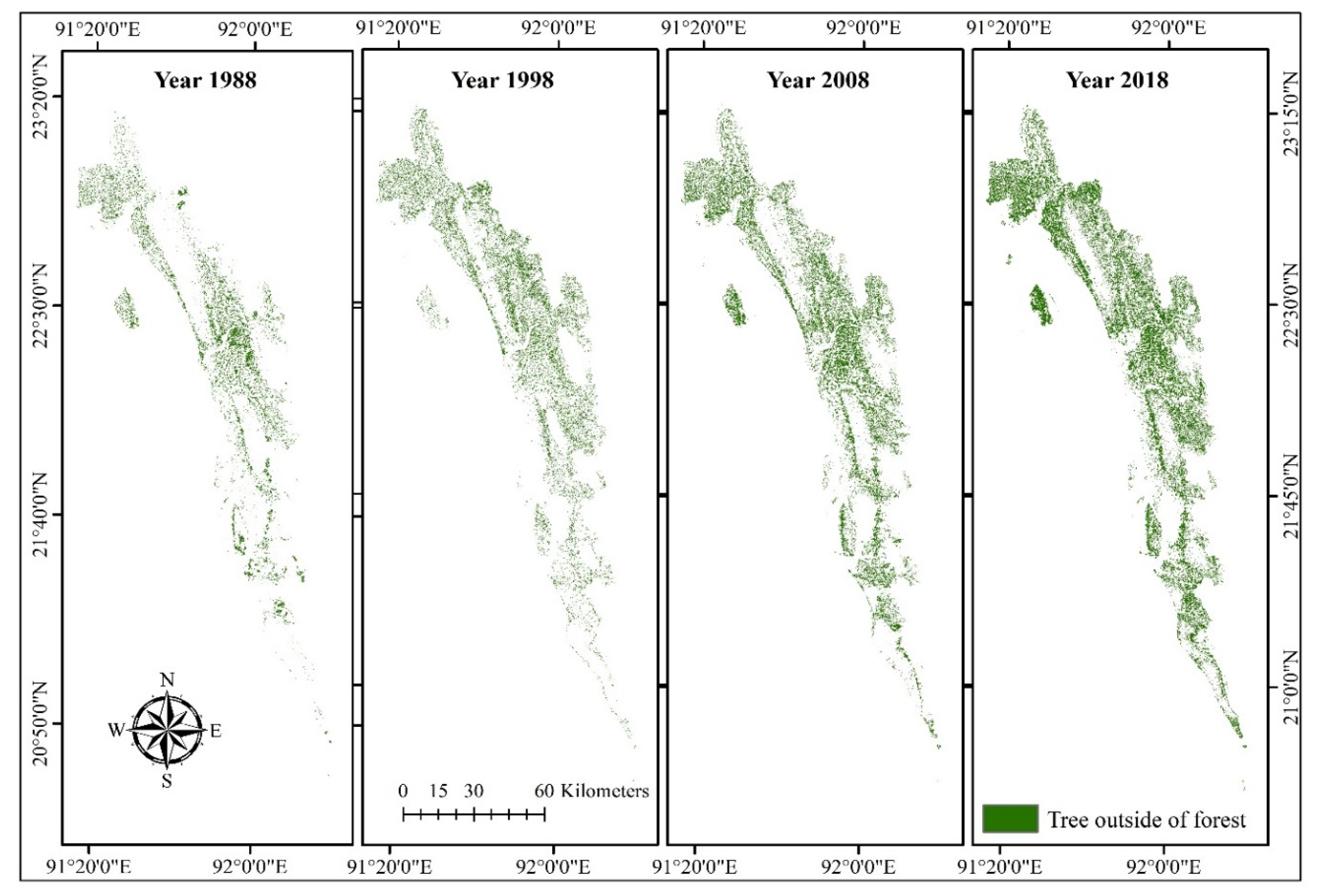
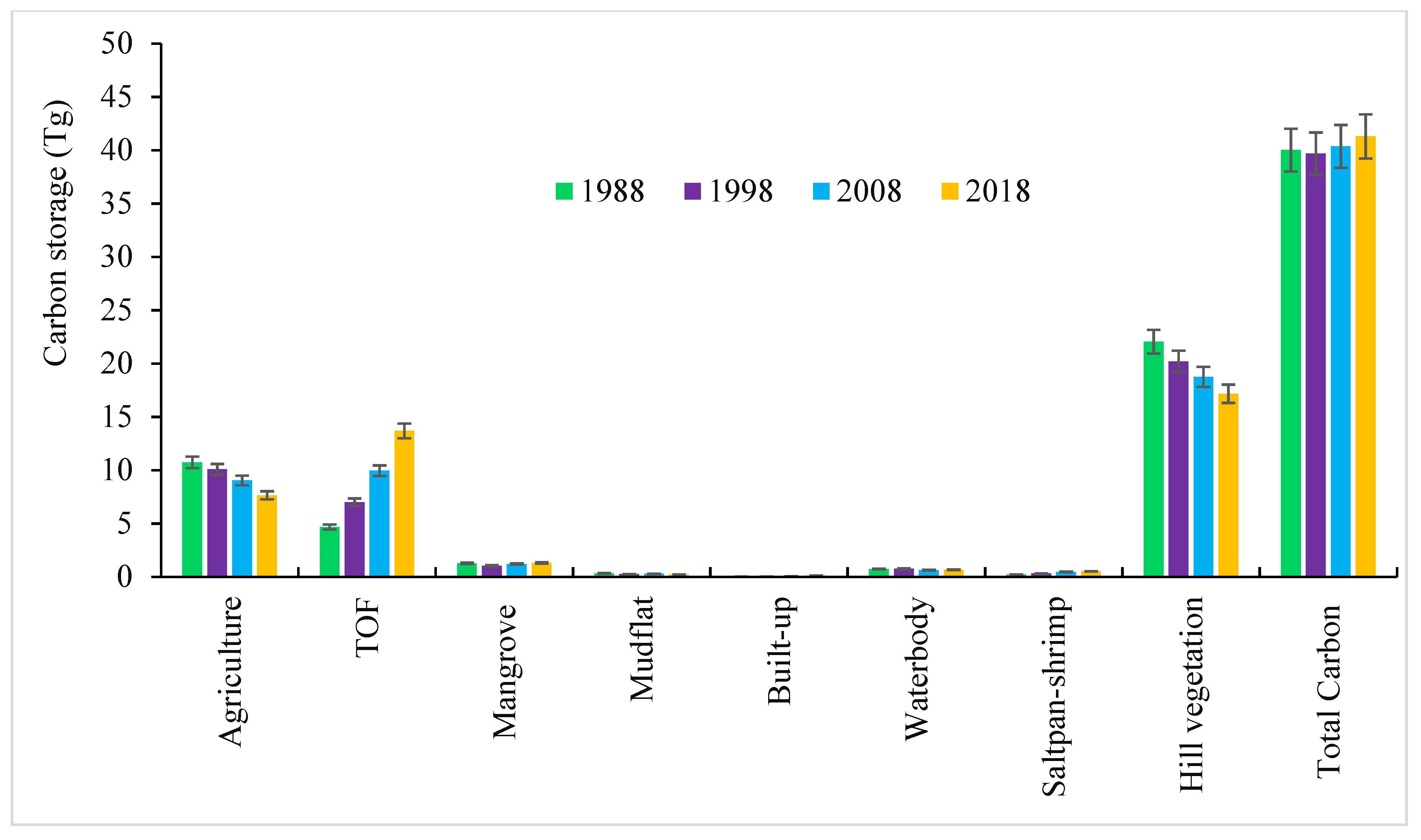
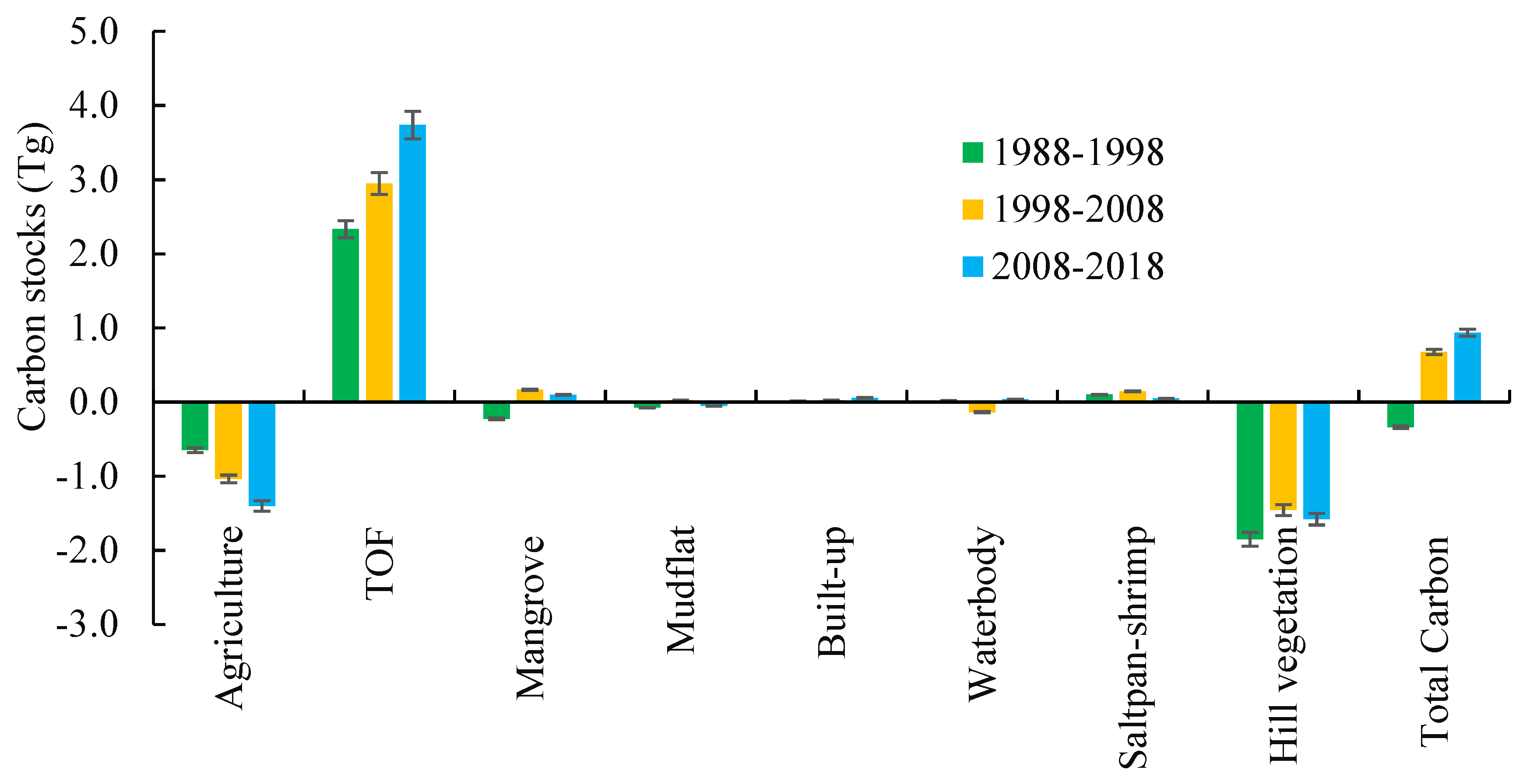
| LULC Class | High Resolution Google Earth Image of Different LULC | Aerial Photography of Different LULC | Description |
|---|---|---|---|
| Agricultural land | 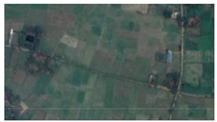 | 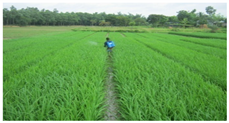 | Cultivated and uncultivated crop field, short fallow land |
| Tree outside of forest (TOF) |  | 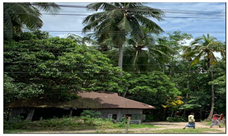 | Planted fruit, timber, and fuel wood trees in and around the rural settlements |
| Mangroves | 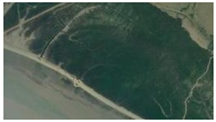 | 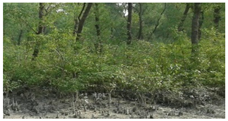 | Natural/plantation mangrove forest ecosystem near the sea shoreline |
| Mudflats |  |  | Newly accreted land (char land), sandy beach, and wetlands |
| Built-up land | 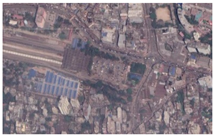 | 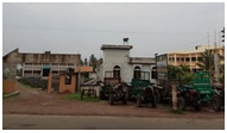 | Urban settlement, industrial areas, highways, and other construction areas |
| Water bodies | 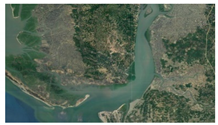 | 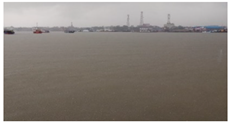 | Rivers, ponds, canals, and other active hydrological units |
| Saltpan-shrimp | 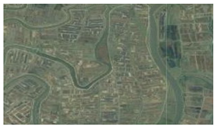 | 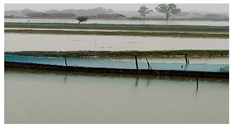 | Salt pan and aquaculture rice dual farming areas |
| Hill vegetation | 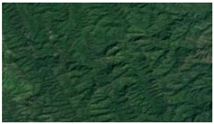 | 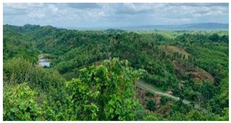 | Dense shrubs and tree vegetation in hilly areas |
| LULC Types | Above-Ground Biomass | Below-Ground Biomass | Soil Organic Matter | Dead Organic Matter | Source |
|---|---|---|---|---|---|
| Agriculture | 8 | 2 | 13 | 1 | [13,14,43] |
| TOF | 36 | 3 | 21 | 2 | [13,14,43] |
| Mangroves | 62 | 28 | 61 | 2 | [14,43,45] |
| Mudflats | 1 | 0 | 12 | 0 | [44] |
| Built-up land | 0 | 0 | 8 | 0 | [44] |
| Water bodies | 2 | 1 | 10 | 0 | [44] |
| Saltpan-shrimp | 1 | 0 | 12 | 0 | [44] |
| Hill vegetation | 101.1 | 8.4 | 16.2 | 8.0 | [13,14,43] |
| LULC Class | 1988 | Year 1998 | Year 2008 | Year 2018 | 1988–2018 | |||||
|---|---|---|---|---|---|---|---|---|---|---|
| Ha | % | Ha | % | Ha | % | Ha | % | Ha | % Change Yr−1 | |
| Agricultural land | 446,863 | 56.1 | 419,903 | 52.7 | 376,687 | 47.3 | 318,277 | 40.0 | −128,586 | −0.54 |
| TOF | 75,322 | 9.5 | 112,931 | 14.2 | 160,495 | 20.2 | 220,715 | 27.7 | +145,393 | 0.61 |
| Mangroves | 8283 | 1.0 | 6787 | 0.9 | 7871 | 1.0 | 8507 | 1.1 | +224 | 0.00 |
| Mudflats | 25,426 | 3.2 | 19,450 | 2.4 | 21,316 | 2.7 | 17,233 | 2.2 | −8193 | −0.03 |
| Built-up land | 2032 | 0.3 | 3409 | 0.4 | 6423 | 0.8 | 13,551 | 1.7 | +11,519 | 0.05 |
| Water bodies | 56,571 | 7.1 | 58,200 | 7.3 | 47,661 | 6.0 | 50,379 | 6.3 | −6192 | −0.03 |
| Saltpan-shrimp | 16,956 | 2.1 | 24,624 | 3.1 | 35,755 | 4.5 | 39,363 | 4.9 | +22,407 | 0.09 |
| Hill vegetation | 164,919 | 20.7 | 151,069 | 19.0 | 140,164 | 17.6 | 128,347 | 16.1 | −36,571 | −0.15 |
Publisher’s Note: MDPI stays neutral with regard to jurisdictional claims in published maps and institutional affiliations. |
© 2022 by the authors. Licensee MDPI, Basel, Switzerland. This article is an open access article distributed under the terms and conditions of the Creative Commons Attribution (CC BY) license (https://creativecommons.org/licenses/by/4.0/).
Share and Cite
Islam, I.; Cui, S.; Hoque, M.Z.; Abdullah, H.M.; Tonny, K.F.; Ahmed, M.; Ferdush, J.; Xu, L.; Ding, S. Dynamics of Tree outside Forest Land Cover Development and Ecosystem Carbon Storage Change in Eastern Coastal Zone, Bangladesh. Land 2022, 11, 76. https://doi.org/10.3390/land11010076
Islam I, Cui S, Hoque MZ, Abdullah HM, Tonny KF, Ahmed M, Ferdush J, Xu L, Ding S. Dynamics of Tree outside Forest Land Cover Development and Ecosystem Carbon Storage Change in Eastern Coastal Zone, Bangladesh. Land. 2022; 11(1):76. https://doi.org/10.3390/land11010076
Chicago/Turabian StyleIslam, Imranul, Shenghui Cui, Muhammad Ziaul Hoque, Hasan Muhammad Abdullah, Kaniz Fatima Tonny, Minhaz Ahmed, Jannatul Ferdush, Lilai Xu, and Shengping Ding. 2022. "Dynamics of Tree outside Forest Land Cover Development and Ecosystem Carbon Storage Change in Eastern Coastal Zone, Bangladesh" Land 11, no. 1: 76. https://doi.org/10.3390/land11010076
APA StyleIslam, I., Cui, S., Hoque, M. Z., Abdullah, H. M., Tonny, K. F., Ahmed, M., Ferdush, J., Xu, L., & Ding, S. (2022). Dynamics of Tree outside Forest Land Cover Development and Ecosystem Carbon Storage Change in Eastern Coastal Zone, Bangladesh. Land, 11(1), 76. https://doi.org/10.3390/land11010076






